-
Paper Information
- Previous Paper
- Paper Submission
-
Journal Information
- About This Journal
- Editorial Board
- Current Issue
- Archive
- Author Guidelines
- Contact Us
International Journal of Control Science and Engineering
p-ISSN: 2168-4952 e-ISSN: 2168-4960
2011; 1(1): 22-27
doi: 10.5923/j.control.20110101.04
Full Averaging of Set Integrodifferential Equations
Tatyana A. Komleva 1, Anastasiya V. Arsirii 2
1Department Mathematics, Odessa State Academy Civil Engineering and Architecture, Odessa, 65029, Ukraine
2Department Optimal Control, Odessa National University, Odessa, 65026, Ukraine
Correspondence to: Tatyana A. Komleva , Department Mathematics, Odessa State Academy Civil Engineering and Architecture, Odessa, 65029, Ukraine.
| Email: |  |
Copyright © 2012 Scientific & Academic Publishing. All Rights Reserved.
In this article we prove the substantiation of the method of full averaging for the set integrodifferential equations with small parameter.
Keywords: Set Integrodifferential Equation, Method of Averaging, Hukuhara Derivative
Cite this paper: Tatyana A. Komleva , Anastasiya V. Arsirii , "Full Averaging of Set Integrodifferential Equations", International Journal of Control Science and Engineering, Vol. 1 No. 1, 2011, pp. 22-27. doi: 10.5923/j.control.20110101.04.
1. Introduction
- As is generally known the absence of exact universal research methods for many important problems of analytical dynamics has caused the development of numerous approximate analytic and numerically-analytic methods that can be realized in effective computer algorithms.The averaging methods combined with the asymptotic representations began to be applied as the basic constructive tool for solving the complicated problems of analytical dynamics described by the differential equations. It became possible due to the works of N.M. Krylov, N.N. Bogolyubov, Yu.A. Mitropolskij, V.M. Volosov, N.N. Moiseev, etc. (see [1-8]).In recent years the development of the calculus in metric spaces has attracted some attention [6-12]. Earlier, F.S. de Blasi, F. Iervolino [13] started the investigation of set differential equations (SDEs) in semilinear metric spaces. This has now evolved into the theory of SDEs as an independent discipline: properties of solutions [6-45], the impulse equations [6,7,41], control systems [42-45] and asymptotic methods [6-8,46-50]. On the other hand, SDEs are useful in other areas of mathematics. For example, SDEs are used, as an auxiliary tool, to prove existence results for differential inclusions [6,30,35,39]. Also, one can employ SDEs in the investigation of fuzzy differential equations [7,10,25-27, 29,30]. Moreover, SDEs are a natural generalization of the usual ordinary differential equations in finite (or infinite) dimensional Banach spaces.In this article we prove the substantiation of the method of full averaging for the set integrodifferential equations with small parameter. Thereby we expand a circle of systems to which it is possible to apply Krylov-Bogolyubov method of averaging.
2. Preliminaries
- Let
 be a set of all nonempty (convex) compact subsets from the space
be a set of all nonempty (convex) compact subsets from the space ,
, be Hausdorff distance between sets
be Hausdorff distance between sets  and
and ,
,  is
is  -neighborhood of set
-neighborhood of set .Let
.Let  be in
be in . The set
. The set  is the Hukuhara difference of
is the Hukuhara difference of  and
and , if
, if , i.e.
, i.e.  From Radstrom's Cancellation Lemma [51], it follows that if this difference exists, then it is unique.Definition [52]. A mapping
From Radstrom's Cancellation Lemma [51], it follows that if this difference exists, then it is unique.Definition [52]. A mapping  is differentiable in the sense of Hukuhara at
is differentiable in the sense of Hukuhara at  if for some
if for some  the Hukuhara differences
the Hukuhara differences  exists in
exists in  for all
for all  and there exists an
and there exists an  such that
such that  and
and  .Here
.Here  is called the Hukuhara derivative of
is called the Hukuhara derivative of  at
at .
.3. The Scheme of Full Average
- Consider the Cauchy problem with small parameter
 | (1) |
 is a small parameter,
is a small parameter,  ,
,  is a set mapping,
is a set mapping,  is a set mapping, Here the integral is understood in the sense of[52] (the integral exists for example if
is a set mapping, Here the integral is understood in the sense of[52] (the integral exists for example if  is measurable and the real mapping
is measurable and the real mapping  is integrable on
is integrable on ),
), .Definition. A mapping
.Definition. A mapping  is a solution to the problem (1) if and only if it is continuous and satisfies the integral equation
is a solution to the problem (1) if and only if it is continuous and satisfies the integral equation for all
for all .In the beginning this section we associate with the equation (1) the following full averaged integrodifferential equation
.In the beginning this section we associate with the equation (1) the following full averaged integrodifferential equation | (2) |
 | (3) |
 | (4) |
 , if for any
, if for any  and any
and any  there exists
there exists  such that.
such that. for all
for all .Theorem. Let in domain.
.Theorem. Let in domain. the following hold:1)
the following hold:1)  is continuous in
is continuous in  2)
2)  is continuous in
is continuous in ;3) there exist continuous function
;3) there exist continuous function , and constant
, and constant  such that
such that  for any
for any ;4)
;4)  , where
, where  5) there exist constants
5) there exist constants ,
,  such that
such that  for any
for any ;6) the limit (3) exist uniformly in
;6) the limit (3) exist uniformly in ;7) for any
;7) for any  and
and  the solution of the equation (2) together with a
the solution of the equation (2) together with a  -neighborhood belong to the domain
-neighborhood belong to the domain .Then for any
.Then for any  and
and  there exists
there exists  such that for all
such that for all  and
and  the following statement fulfill:
the following statement fulfill: | (5) |
 ,
,  are the solutions of the initial and the full averaged equations.Proof. Since.
are the solutions of the initial and the full averaged equations.Proof. Since. we have
we have 
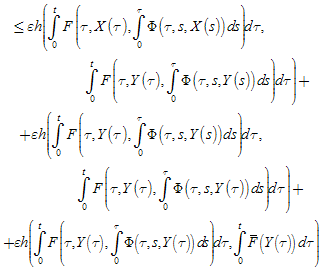 Hence
Hence 
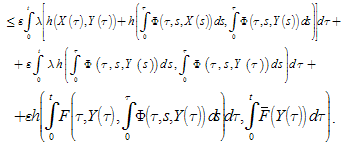 Then we obtain
Then we obtain 
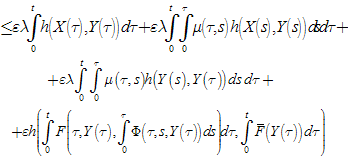 | (6) |
 into partial intervals by the points
into partial intervals by the points  Then
Then where
where As
As  for all
for all ,
, ; then
; then 
 Hence
Hence where
where .Obviously,
.Obviously,  , and
, and .Now, we will estimate
.Now, we will estimate . From condition 6) of the theorem it follows that there exists the increasing function
. From condition 6) of the theorem it follows that there exists the increasing function  such that1)
such that1)  ;2)
;2)  .Then
.Then 
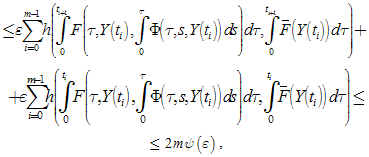 Where
Where  By (6), we have
By (6), we have 
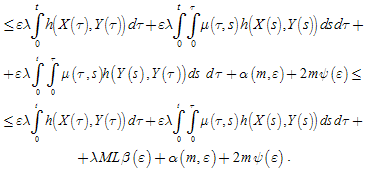 Using Gronwall-Bellman's inequality, we obtain
Using Gronwall-Bellman's inequality, we obtain Fix
Fix . Then for any
. Then for any , there exists
, there exists  such that the following estimate is true for
such that the following estimate is true for :
: Hence we obtain
Hence we obtain  for all
for all .This concludes the proof. Now we consider a case when the limit (3) not exists. Then we associate with the equation (1) the following integrodifferential equation
.This concludes the proof. Now we consider a case when the limit (3) not exists. Then we associate with the equation (1) the following integrodifferential equation | (7) |
 the following hold:1)
the following hold:1)  is continuous in
is continuous in  2)
2)  is continuous in
is continuous in ;3) there exist continuous function
;3) there exist continuous function , and constants
, and constants 
 such that
such that  for any
for any ;4)
;4)  , where
, where  5) for any
5) for any  and
and  the solutions of the equations (1) and (7) together with a
the solutions of the equations (1) and (7) together with a  -neighborhood belong to the domain
-neighborhood belong to the domain .Then the statement (8) fulfill:
.Then the statement (8) fulfill: | (8) |
 ,
, .Proof. By (1) and (7) we have
.Proof. By (1) and (7) we have 
 Hence we obtain
Hence we obtain 
 | (9) |

 then by (9) we obtain (8). This concludes the proof.
then by (9) we obtain (8). This concludes the proof.4. Conclusions
- Here we used the approach of Hukuhara at definition of the derivative which has essential shortages. However the given approach is well investigated by many authors. Also in the literature exist other approaches to definition of the derivative[7,8,11,12,25,40], but also they have the shortages. It is easily possible to show that this outcome will be true for some other cases with little changes.
 Abstract
Abstract Reference
Reference Full-Text PDF
Full-Text PDF Full-Text HTML
Full-Text HTML